Abstract
Enteropathogenic Escherichia coli (EPEC) infection is not generally thought to cause severe diarrhoea after the neonatal period. Patients admitted to Queen Elizabeth Hospital for Children over the three years (1984-7) with diarrhoea and EPEC infection were reviewed. Clinical details, features of small intestinal mucosa, and treatment were recorded in those who developed chronic diarrhoea with failure to thrive. Twenty six children with EPEC required hospital admission for diarrhoea and six of these (23%) developed chronic diarrhoea. In contrast only two (5%) of 42 with other serogroups of E coli (p less than 0.01) and 28 (4%) of 764 children without EPEC admitted with acute diarrhoea developed chronic symptoms (p less than 0.01). EPEC serogroups detected in the stool of the six children with chronic diarrhoea were 0128 in three, 0114 in two, and 0119 in one. The patients' clinical characteristics were: previous good health, no significant immunodeficiency, age 4-10 months, foreign travel (three of six), severe life threatening secretory diarrhoea from 0.5 to 1.5 1 per day (four of six), small intestinal enteropathy (five of six) three of whom showed mucosal adherent, non-invasive E coli of the same serotype as that in the stool, in association with microvillous loss and pedestal formation. All were treated with hypoallergenic feeds, two with parenteral nutrition, and three with parenteral antibiotics. All eventually recovered. EPEC infection is a common treatable cause of life threatening chronic diarrhoea in infancy.
Full text
PDF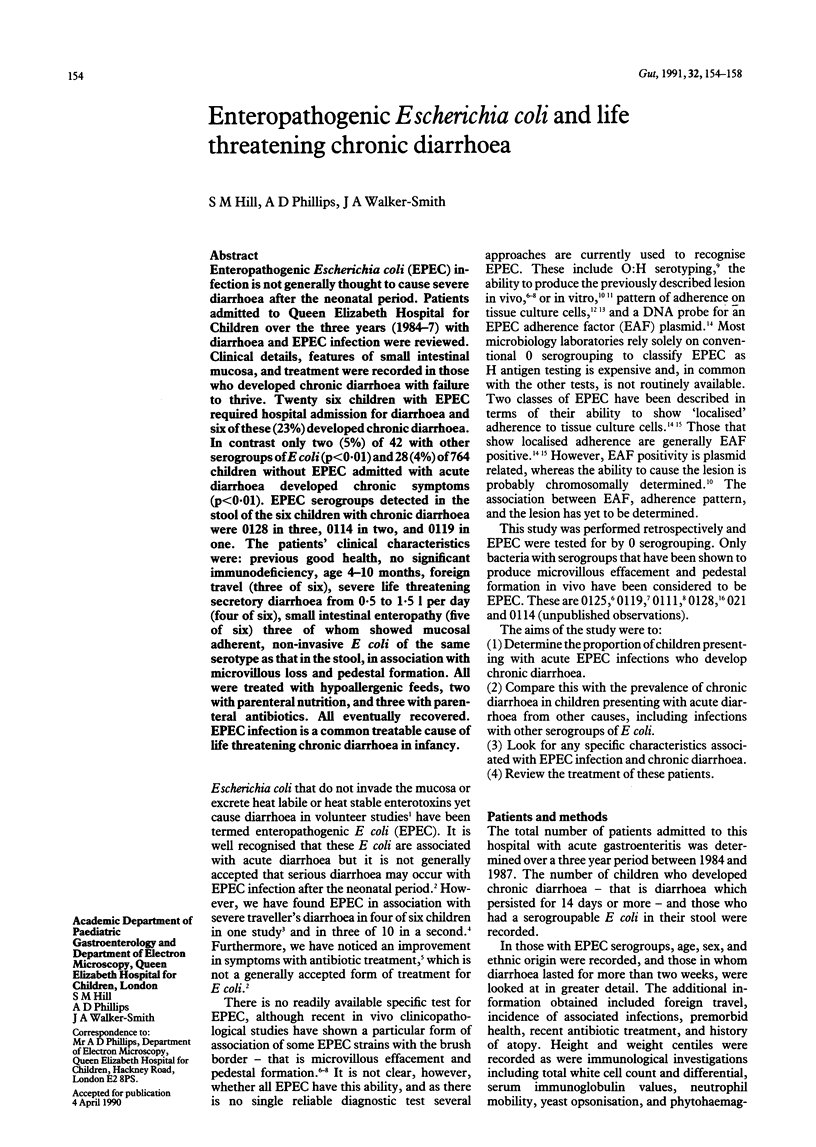
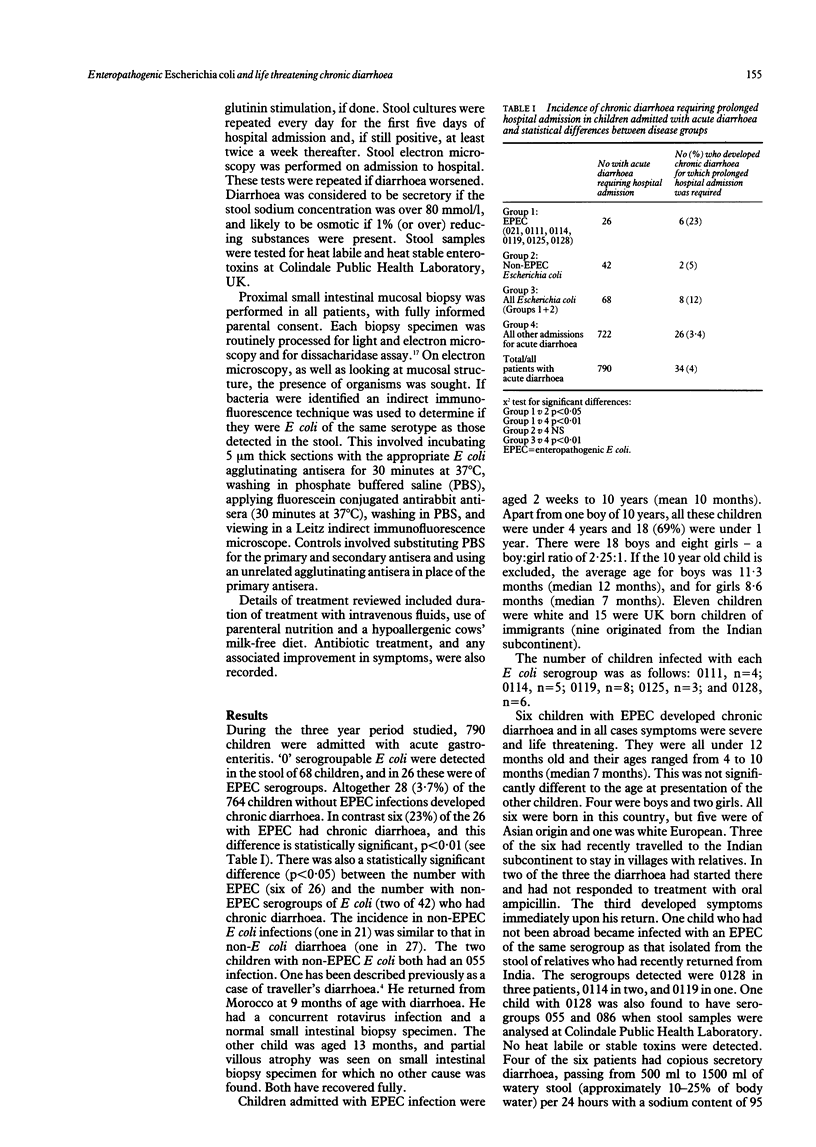
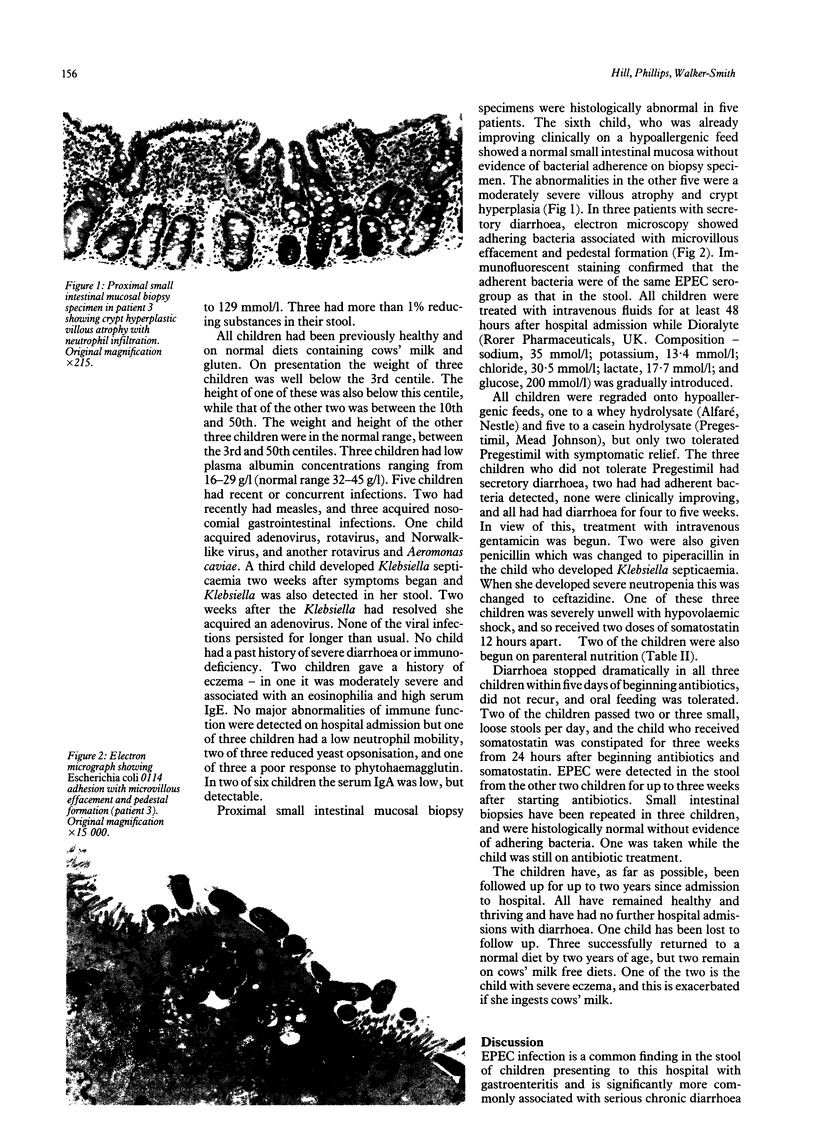
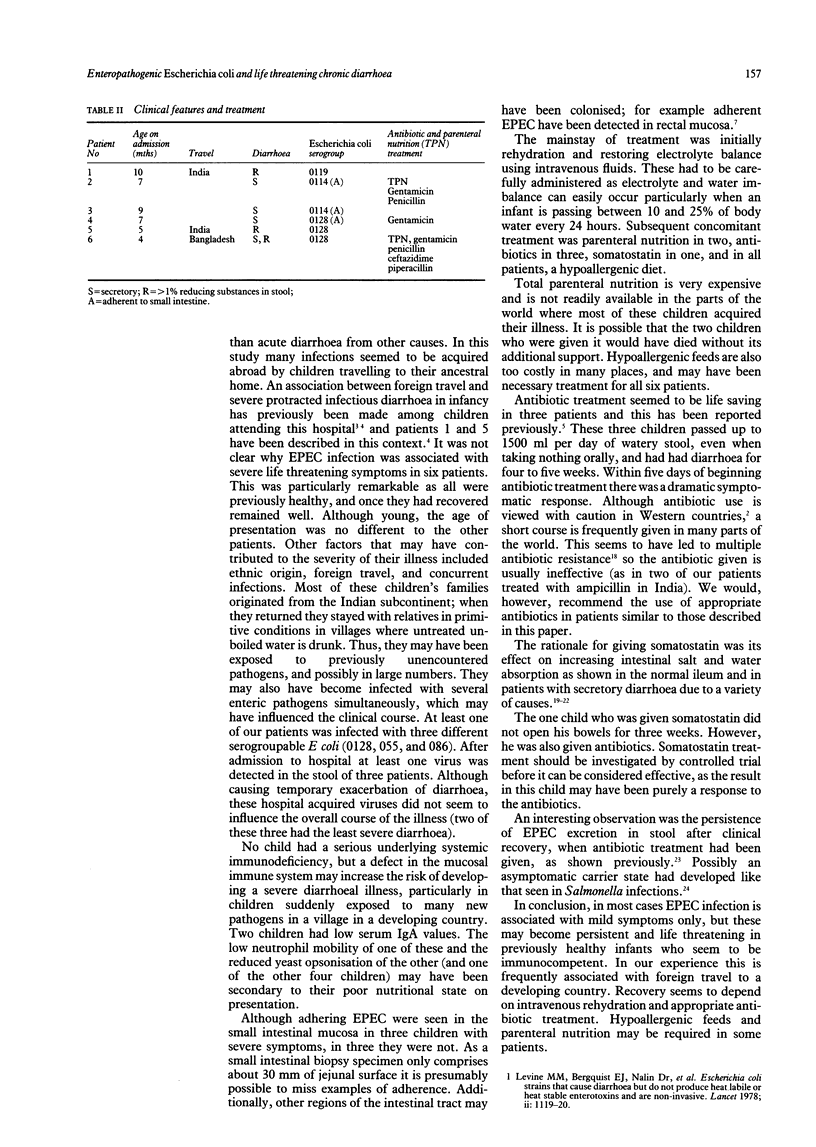
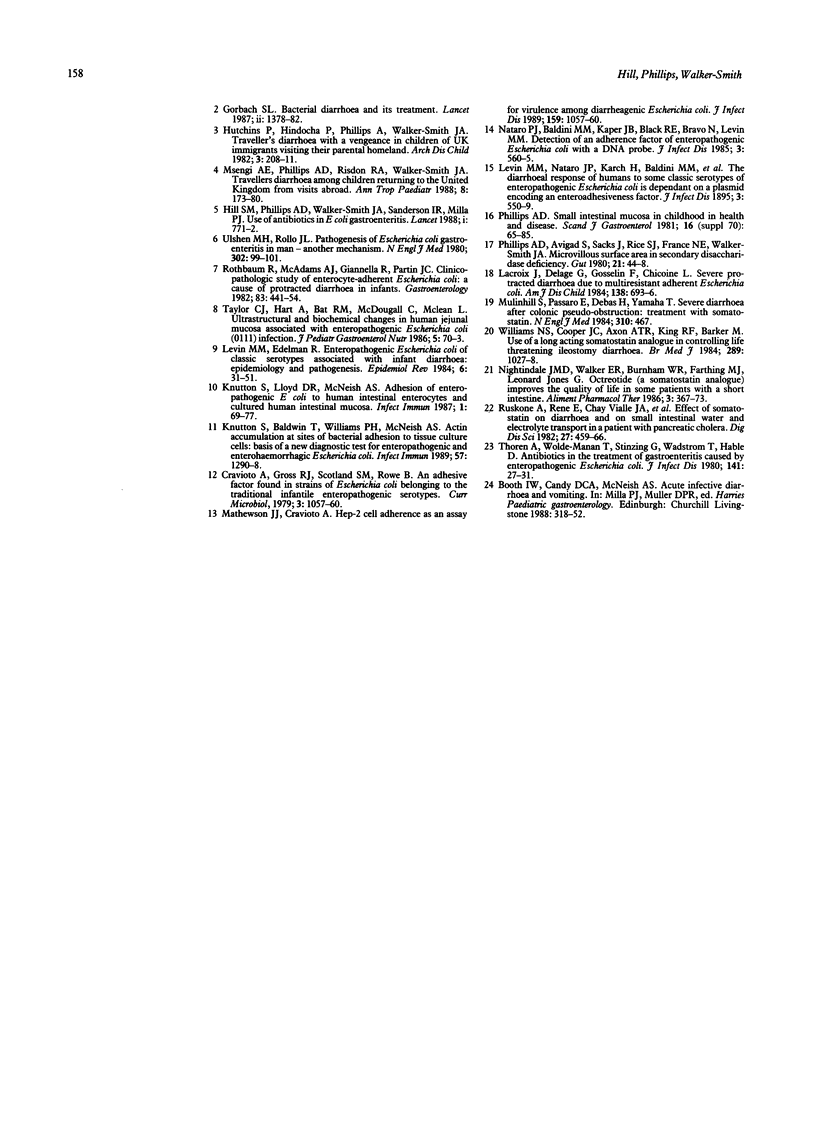
Images in this article
Selected References
These references are in PubMed. This may not be the complete list of references from this article.
- Gorbach S. L. Bacterial diarrhoea and its treatment. Lancet. 1987 Dec 12;2(8572):1378–1382. doi: 10.1016/s0140-6736(87)91267-0. [DOI] [PubMed] [Google Scholar]
- Hill S. M., Phillips A. D., Walker-Smith J. A., Sanderson I. R., Milla P. J. Antibiotics for Escherichia coli gastroenteritis. Lancet. 1988 Apr 2;1(8588):771–772. doi: 10.1016/s0140-6736(88)91584-x. [DOI] [PubMed] [Google Scholar]
- Hutchins P., Hindocha P., Phillips A., Walker-Smith J. Traveller's diarrhoea with a vengeance in children of UK immigrants visiting their parental homeland. Arch Dis Child. 1982 Mar;57(3):208–211. doi: 10.1136/adc.57.3.208. [DOI] [PMC free article] [PubMed] [Google Scholar]
- Knutton S., Baldwin T., Williams P. H., McNeish A. S. Actin accumulation at sites of bacterial adhesion to tissue culture cells: basis of a new diagnostic test for enteropathogenic and enterohemorrhagic Escherichia coli. Infect Immun. 1989 Apr;57(4):1290–1298. doi: 10.1128/iai.57.4.1290-1298.1989. [DOI] [PMC free article] [PubMed] [Google Scholar]
- Knutton S., Lloyd D. R., McNeish A. S. Adhesion of enteropathogenic Escherichia coli to human intestinal enterocytes and cultured human intestinal mucosa. Infect Immun. 1987 Jan;55(1):69–77. doi: 10.1128/iai.55.1.69-77.1987. [DOI] [PMC free article] [PubMed] [Google Scholar]
- Lacroix J., Delage G., Gosselin F., Chicoine L. Severe protracted diarrhea due to multiresistant adherent Escherichia coli. Am J Dis Child. 1984 Jul;138(7):693–696. doi: 10.1001/archpedi.1984.02140450075023. [DOI] [PubMed] [Google Scholar]
- Levine M. M., Bergquist E. J., Nalin D. R., Waterman D. H., Hornick R. B., Young C. R., Sotman S. Escherichia coli strains that cause diarrhoea but do not produce heat-labile or heat-stable enterotoxins and are non-invasive. Lancet. 1978 May 27;1(8074):1119–1122. doi: 10.1016/s0140-6736(78)90299-4. [DOI] [PubMed] [Google Scholar]
- Levine M. M., Edelman R. Enteropathogenic Escherichia coli of classic serotypes associated with infant diarrhea: epidemiology and pathogenesis. Epidemiol Rev. 1984;6:31–51. doi: 10.1093/oxfordjournals.epirev.a036274. [DOI] [PubMed] [Google Scholar]
- Mathewson J. J., Cravioto A. HEp-2 cell adherence as an assay for virulence among diarrheagenic Escherichia coli. J Infect Dis. 1989 Jun;159(6):1057–1060. doi: 10.1093/infdis/159.6.1057. [DOI] [PubMed] [Google Scholar]
- Msengi A. E., Phillips A. D., Risdon R. A., Walker-Smith J. A. Travellers' diarrhoea among children returning to the United Kingdom from visits abroad. Ann Trop Paediatr. 1988 Sep;8(3):173–180. doi: 10.1080/02724936.1988.11748564. [DOI] [PubMed] [Google Scholar]
- Mulvihill S., Passaro E., Jr, Debas H., Yamada T. Severe diarrhea after colonic pseudo-obstruction: treatment with somatostatin. N Engl J Med. 1984 Feb 16;310(7):467–468. doi: 10.1056/NEJM198402163100719. [DOI] [PubMed] [Google Scholar]
- Nataro J. P., Baldini M. M., Kaper J. B., Black R. E., Bravo N., Levine M. M. Detection of an adherence factor of enteropathogenic Escherichia coli with a DNA probe. J Infect Dis. 1985 Sep;152(3):560–565. doi: 10.1093/infdis/152.3.560. [DOI] [PubMed] [Google Scholar]
- Nightingale J. M., Walker E. R., Burnham W. R., Farthing M. J., Lennard-Jones J. E. Octreotide (a somatostatin analogue) improves the quality of life in some patients with a short intestine. Aliment Pharmacol Ther. 1989 Aug;3(4):367–373. doi: 10.1111/j.1365-2036.1989.tb00223.x. [DOI] [PubMed] [Google Scholar]
- Phillips A. D., Avigad S., Sacks J., Rice S. J., France N. E., Walker-Smith J. A. Microvillous surface area in secondary disaccharidase deficiency. Gut. 1980 Jan;21(1):44–48. doi: 10.1136/gut.21.1.44. [DOI] [PMC free article] [PubMed] [Google Scholar]
- Phillips A. D. Small intestinal mucosa in childhood in health and disease. Scand J Gastroenterol Suppl. 1981;70:65–85. [PubMed] [Google Scholar]
- Rothbaum R., McAdams A. J., Giannella R., Partin J. C. A clinicopathologic study of enterocyte-adherent Escherichia coli: a cause of protracted diarrhea in infants. Gastroenterology. 1982 Aug;83(2):441–454. [PubMed] [Google Scholar]
- Ruskoné A., René E., Chayvialle J. A., Bonin N., Pignal F., Kremer M., Bonfils S., Rambaud J. C. Effect of somatostatin on diarrhea and on small intestinal water and electrolyte transport in a patient with pancreatic cholera. Dig Dis Sci. 1982 May;27(5):459–466. doi: 10.1007/BF01295657. [DOI] [PubMed] [Google Scholar]
- Taylor C. J., Hart A., Batt R. M., McDougall C., McLean L. Ultrastructural and biochemical changes in human jejunal mucosa associated with enteropathogenic Escherichia coli (0111) infection. J Pediatr Gastroenterol Nutr. 1986 Jan;5(1):70–73. doi: 10.1097/00005176-198601000-00013. [DOI] [PubMed] [Google Scholar]
- Thorén A., Wolde-Mariam T., Stintzing G., Wadström T., Habte D. Antibiotics in the treatment of gastroenteritis caused by enteropathogenic Escherichia coli. J Infect Dis. 1980 Jan;141(1):27–31. doi: 10.1093/infdis/141.1.27. [DOI] [PubMed] [Google Scholar]
- Ulshen M. H., Rollo J. L. Pathogenesis of escherichia coli gastroenteritis in man--another mechanism. N Engl J Med. 1980 Jan 10;302(2):99–101. doi: 10.1056/NEJM198001103020207. [DOI] [PubMed] [Google Scholar]
- Williams N. S., Cooper J. C., Axon A. T., King R. F., Barker M. Use of a long acting somatostatin analogue in controlling life threatening ileostomy diarrhoea. Br Med J (Clin Res Ed) 1984 Oct 20;289(6451):1027–1028. doi: 10.1136/bmj.289.6451.1027. [DOI] [PMC free article] [PubMed] [Google Scholar]




